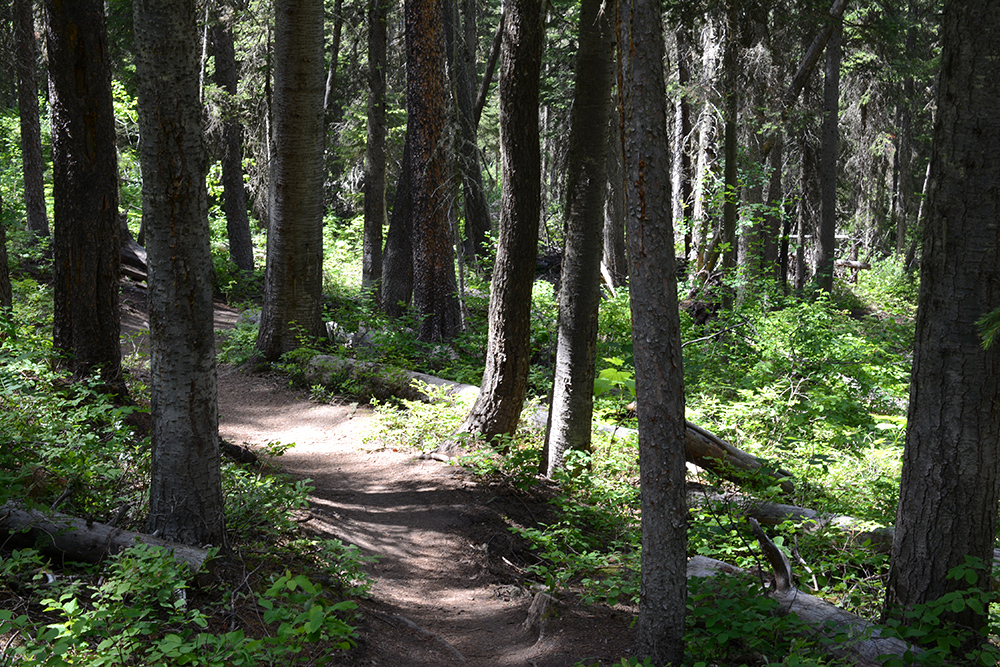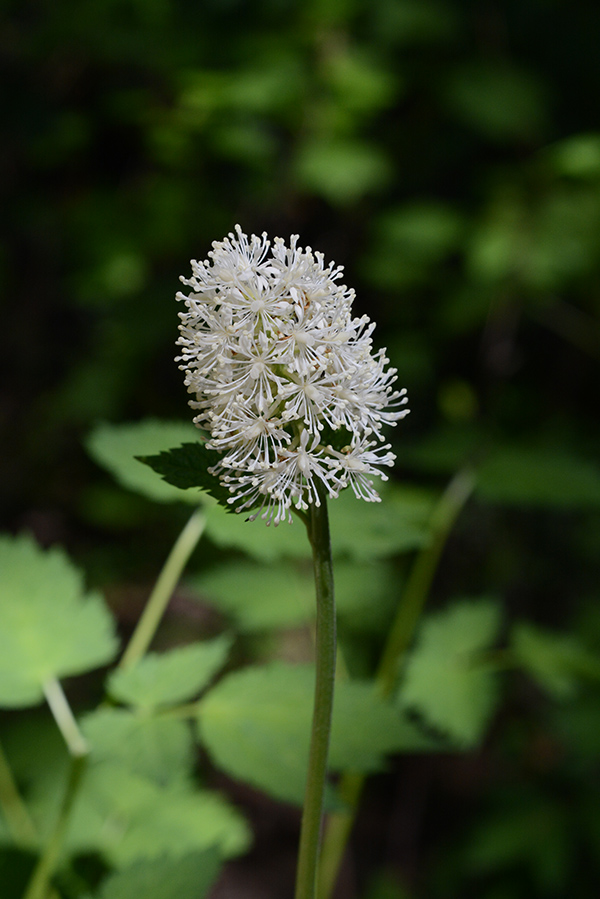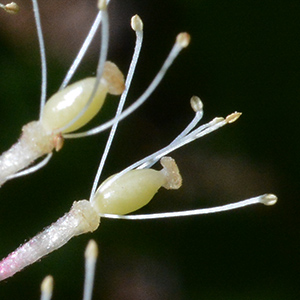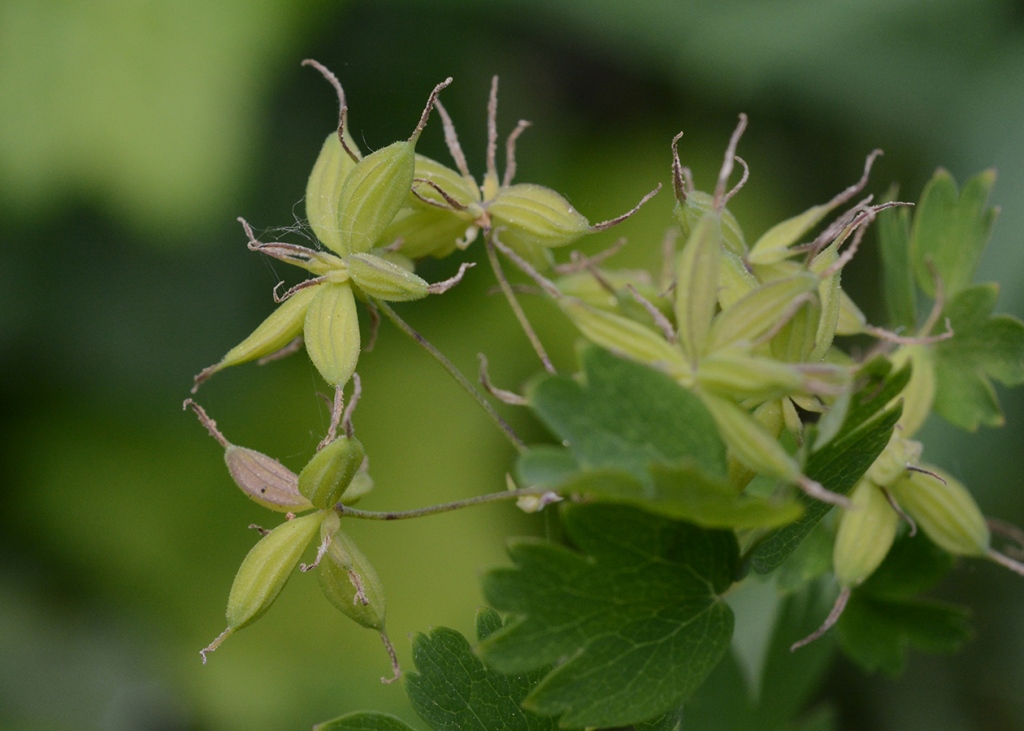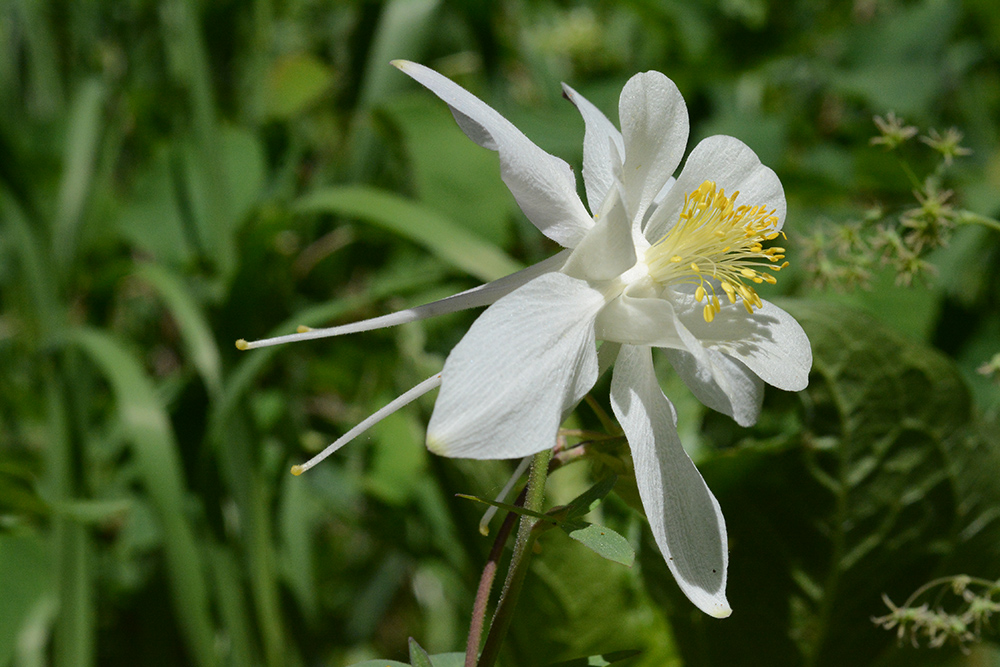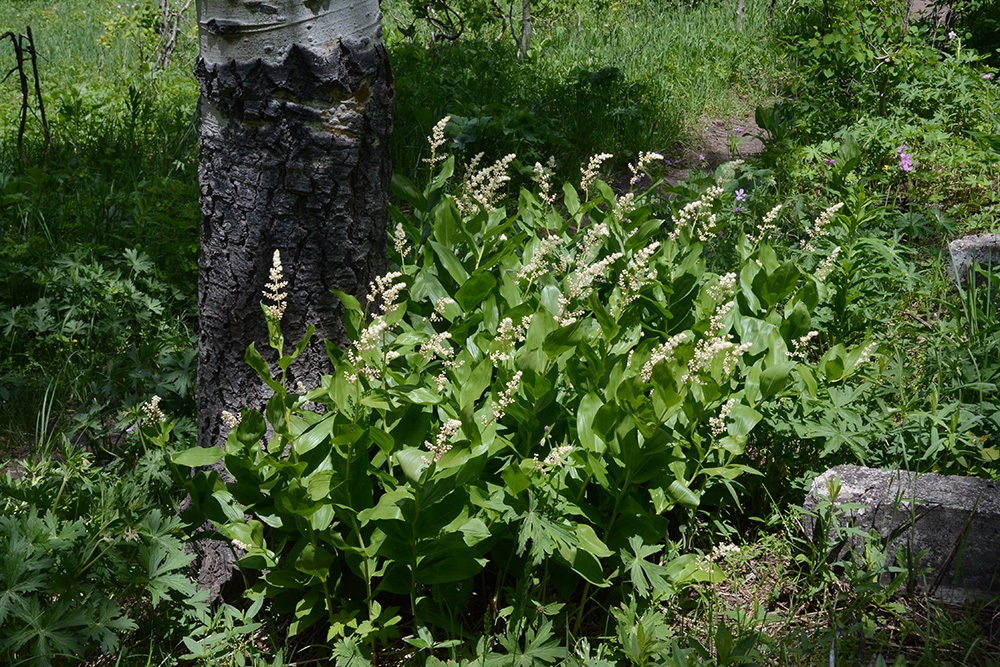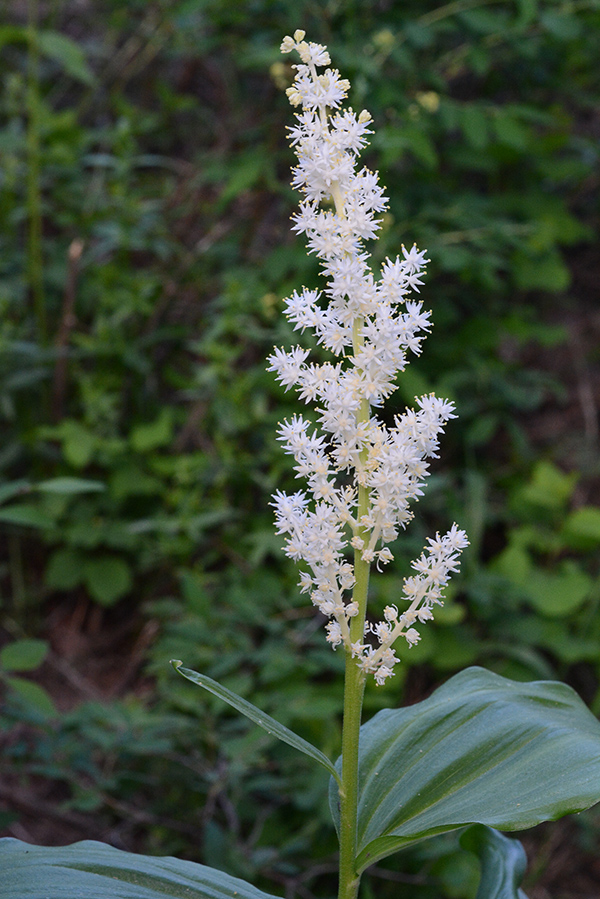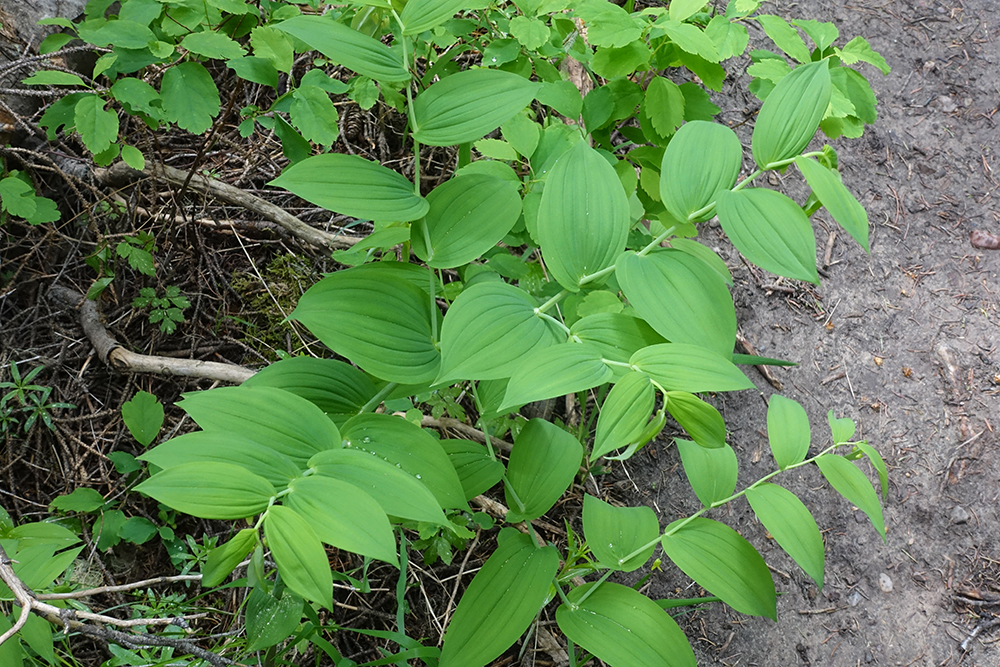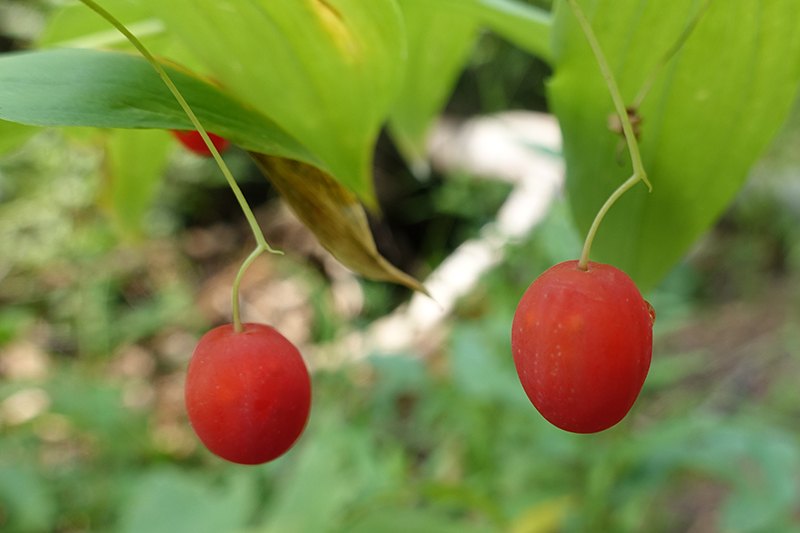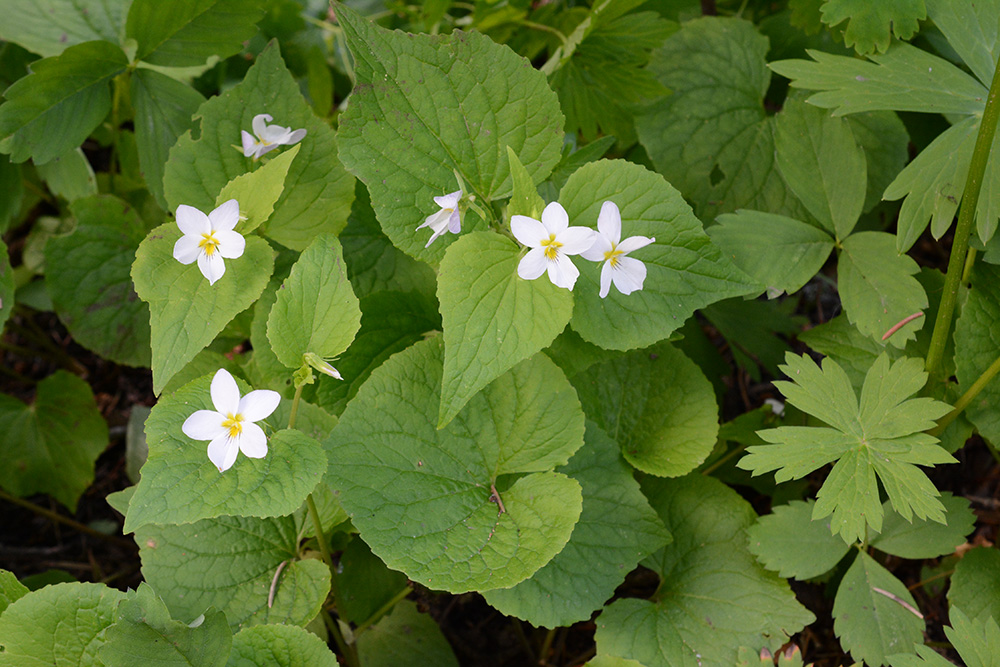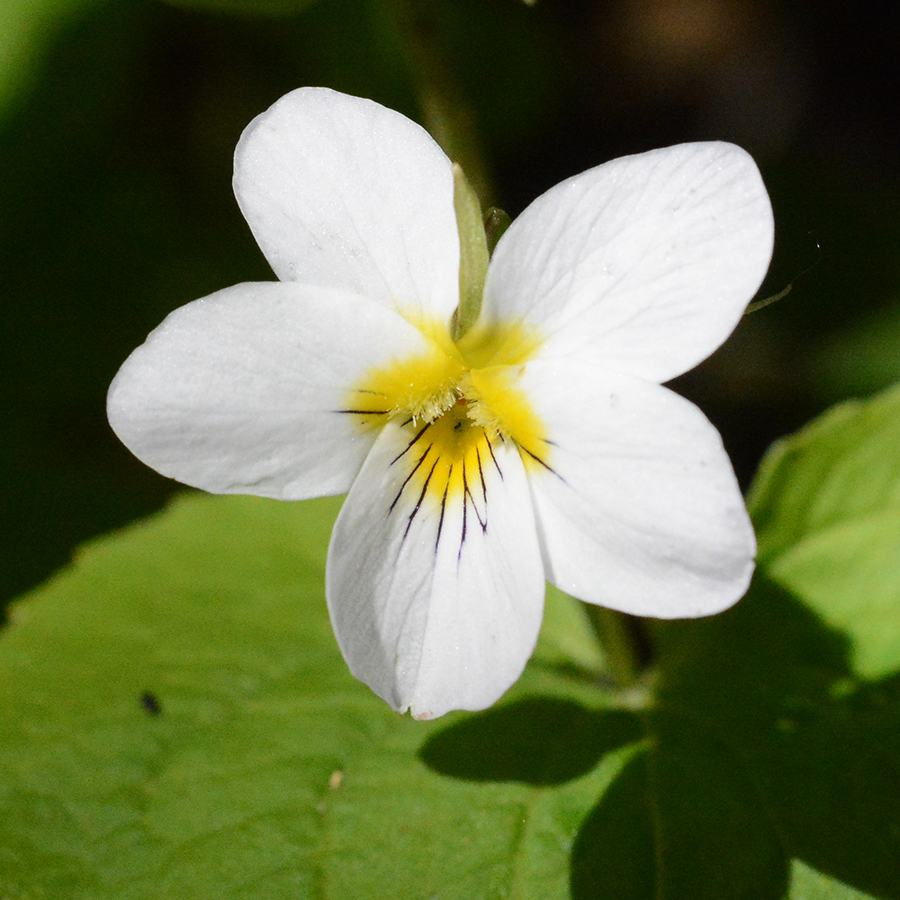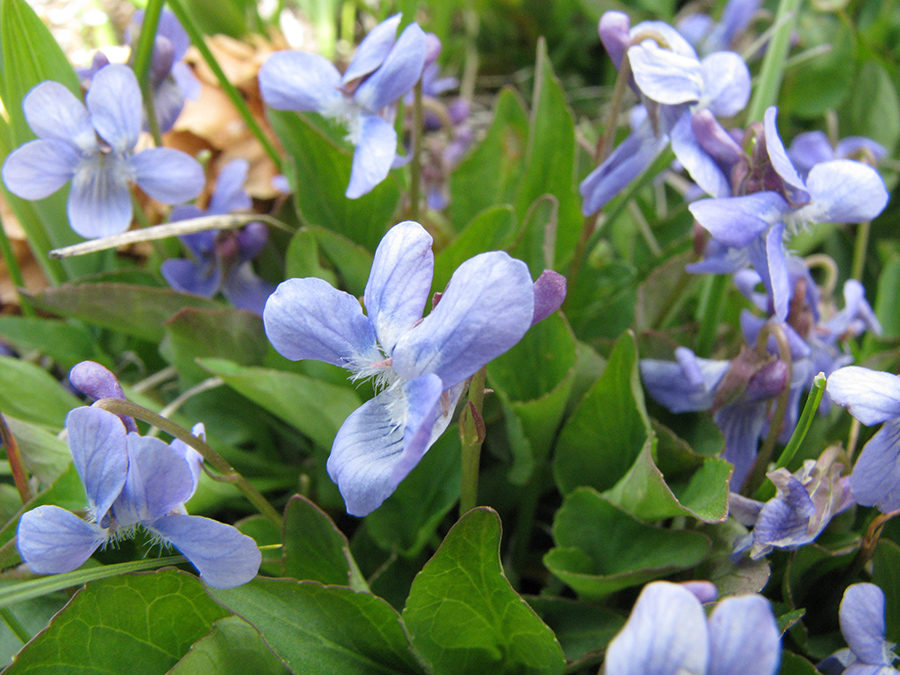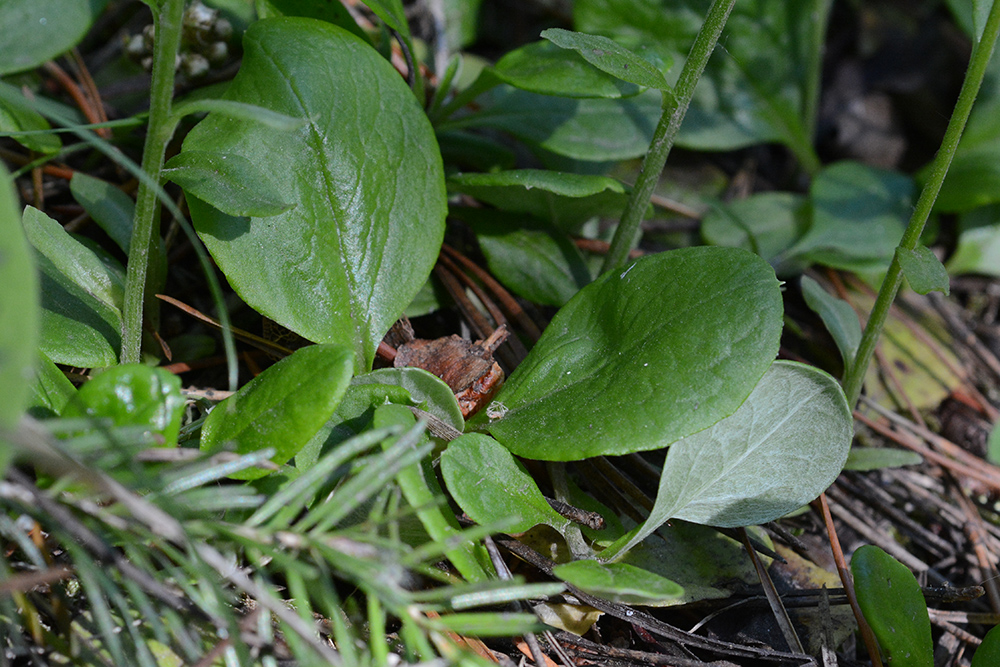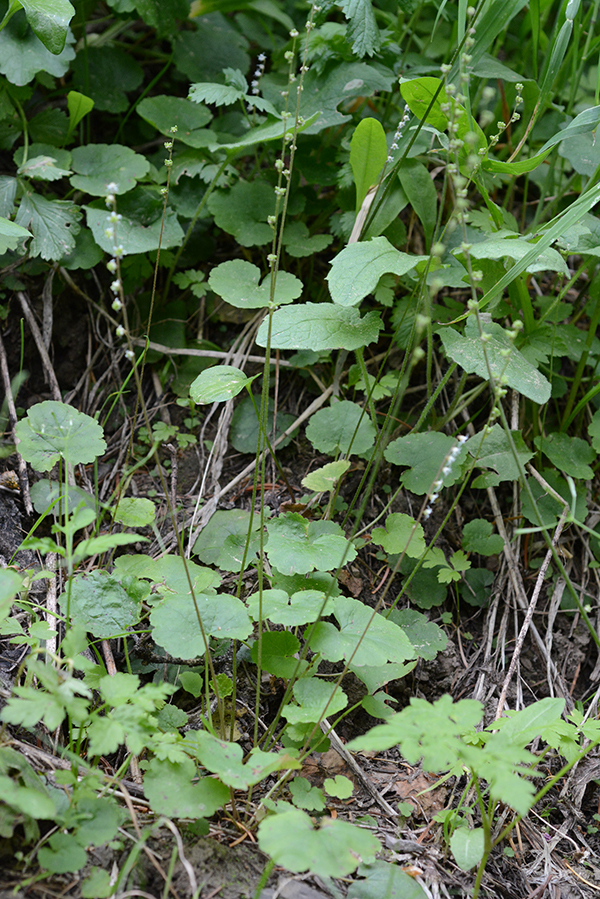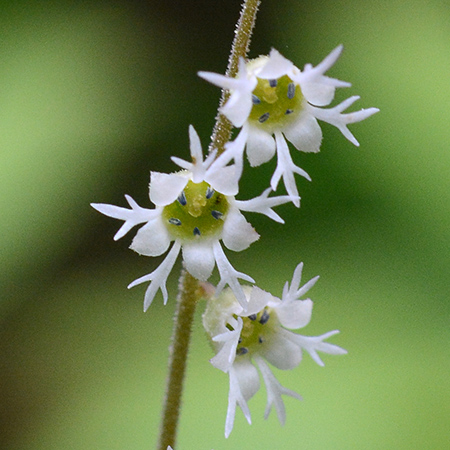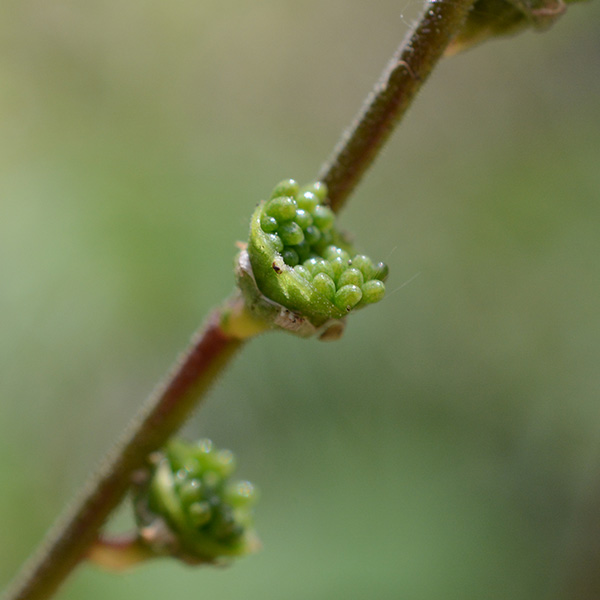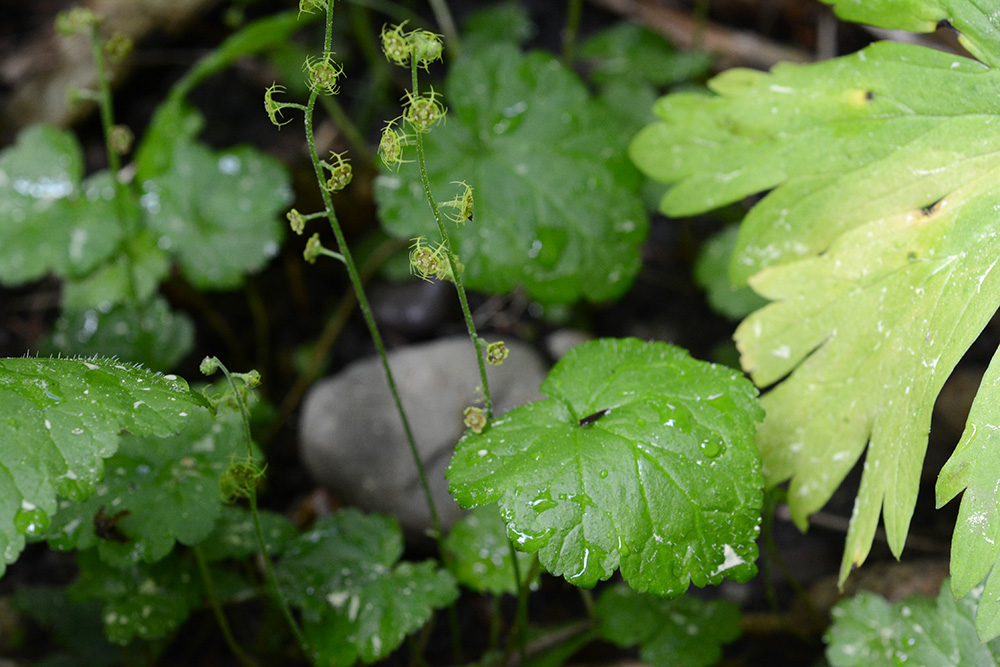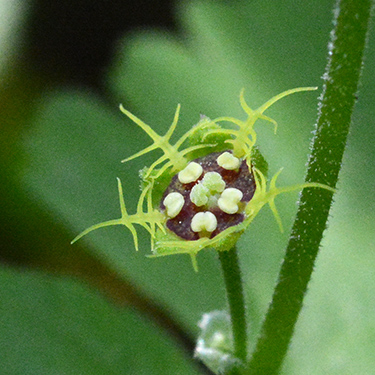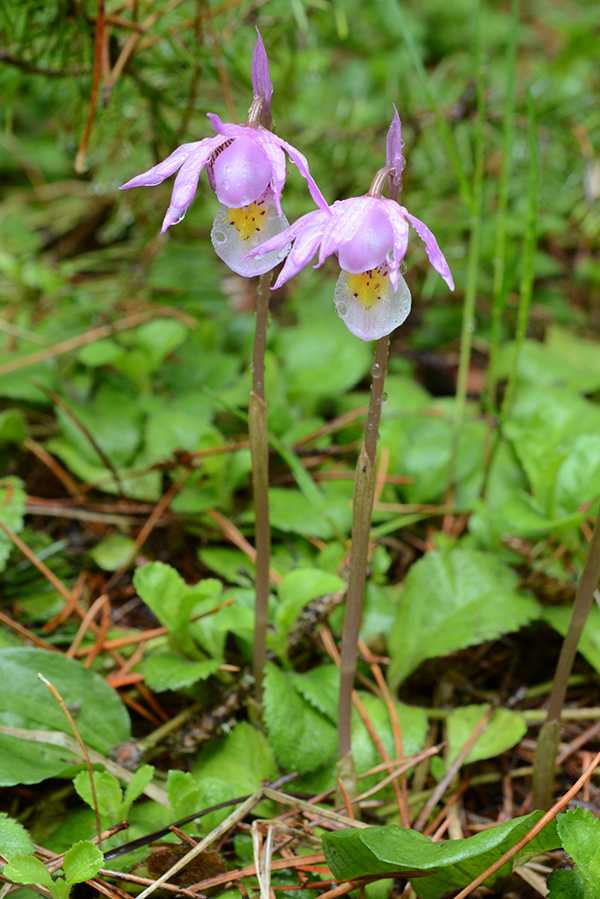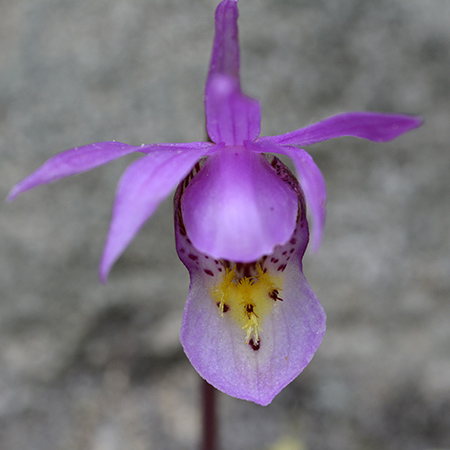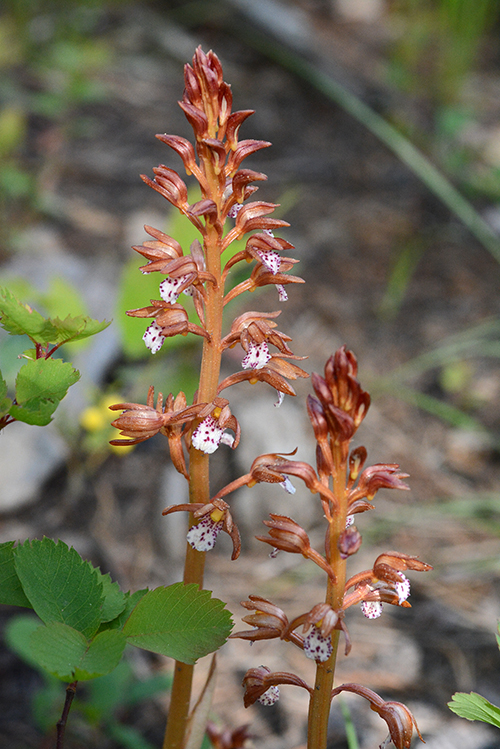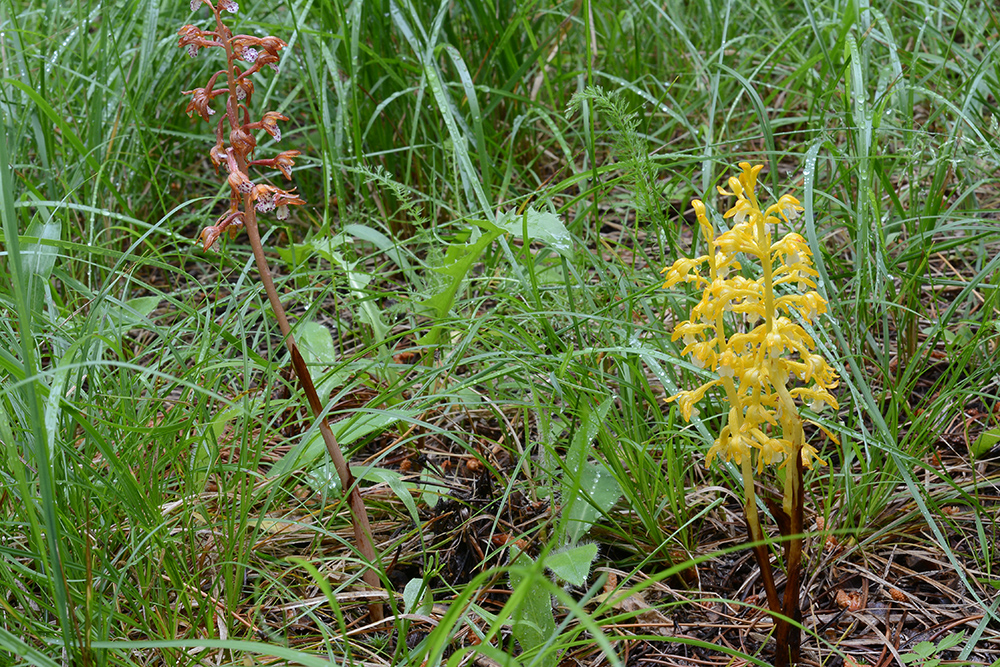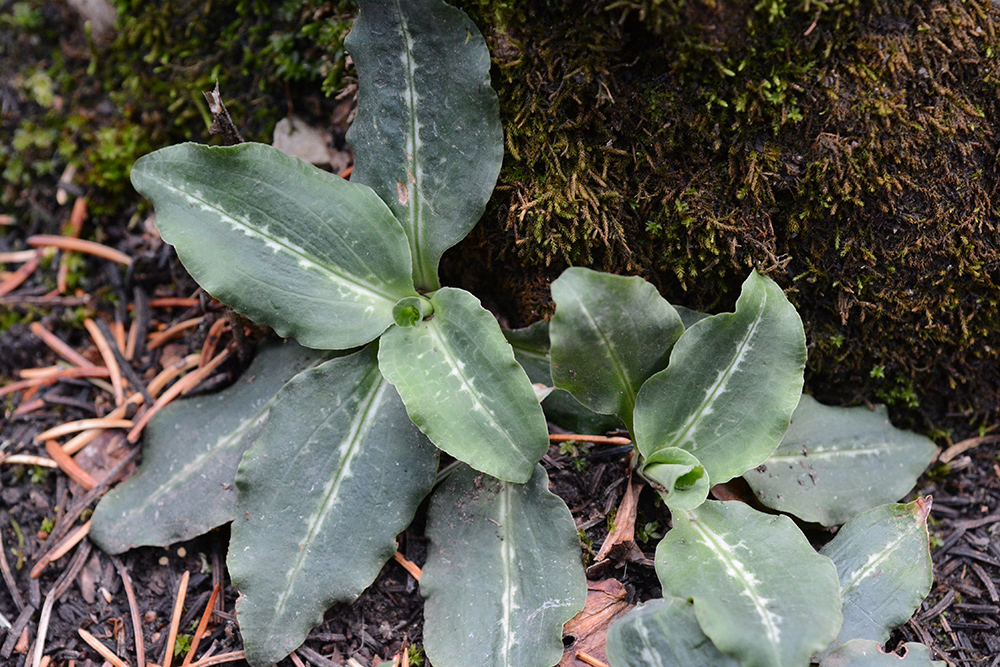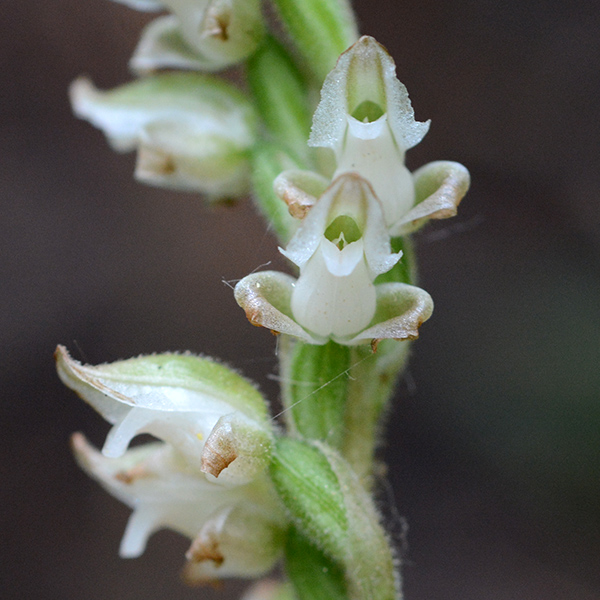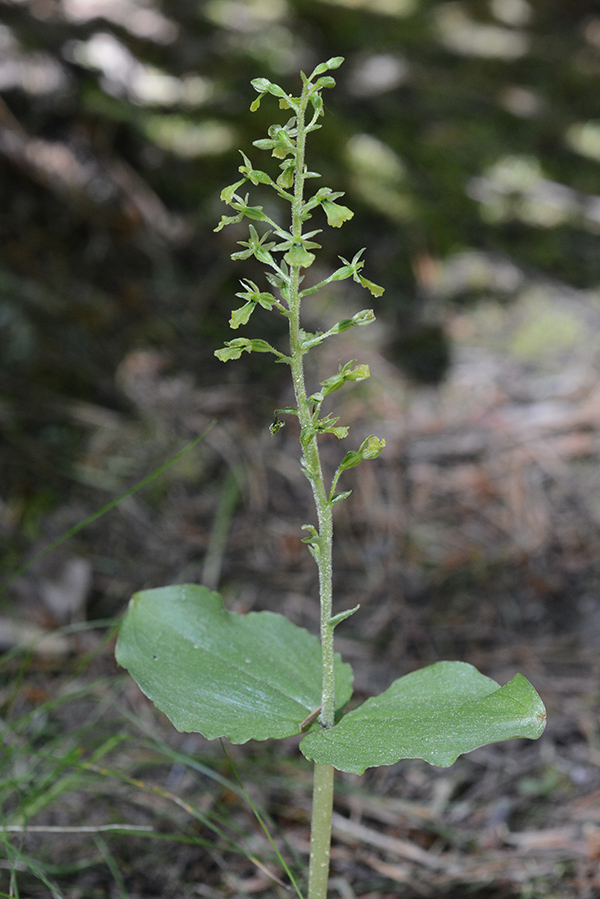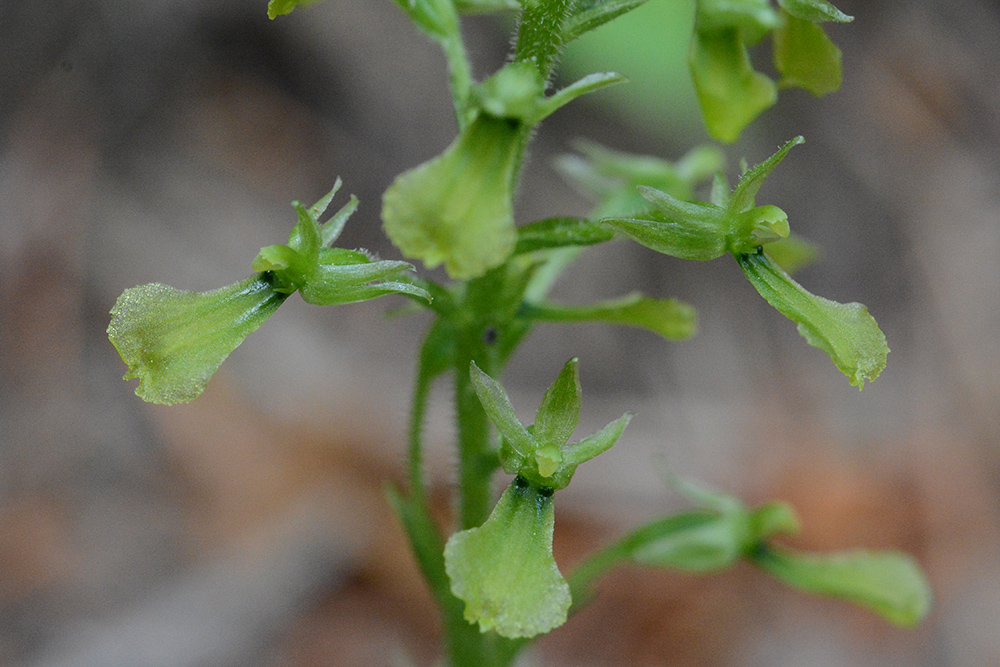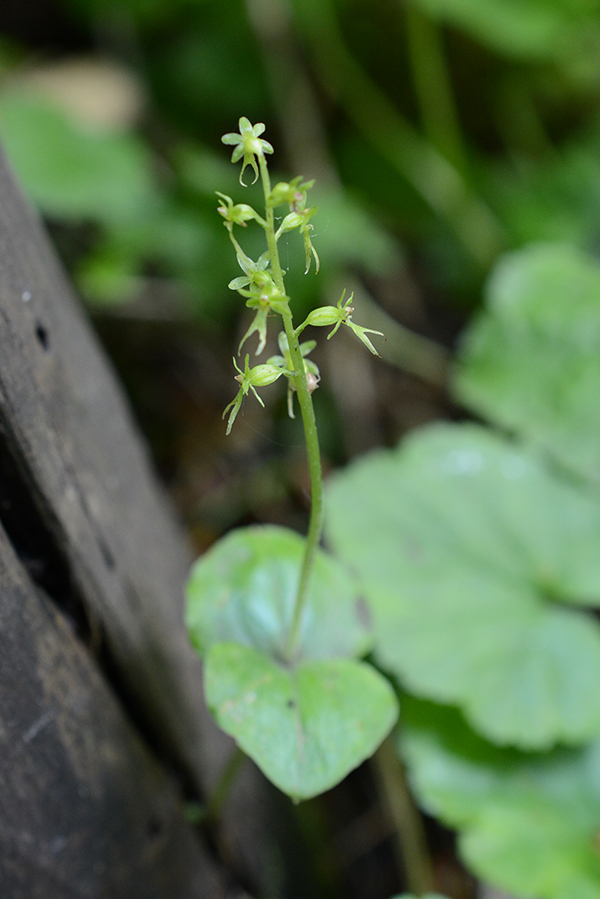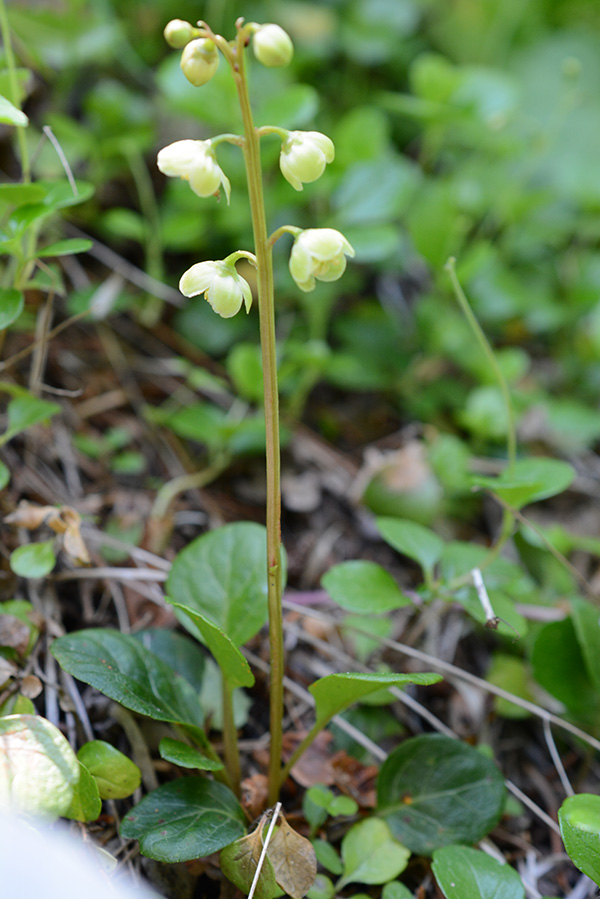This posting complements one of June 20 on Sagebrush Flats. Several of the plants listed there are still blooming, such as spectacular stands of deep-yellow Mule’s-ears, wands of Scarlet Gilia, bunches of Silky Lupines, and occasional False Dandelions along with more plentiful Congested Sandworts. It all depends on location: elevation, aspect, and soils.
At the time of this posting, the most abundant species of the sageflats and sunny sites elsewhere appears to be Sulphur Buckwheat – Eriogonum umbellatum.
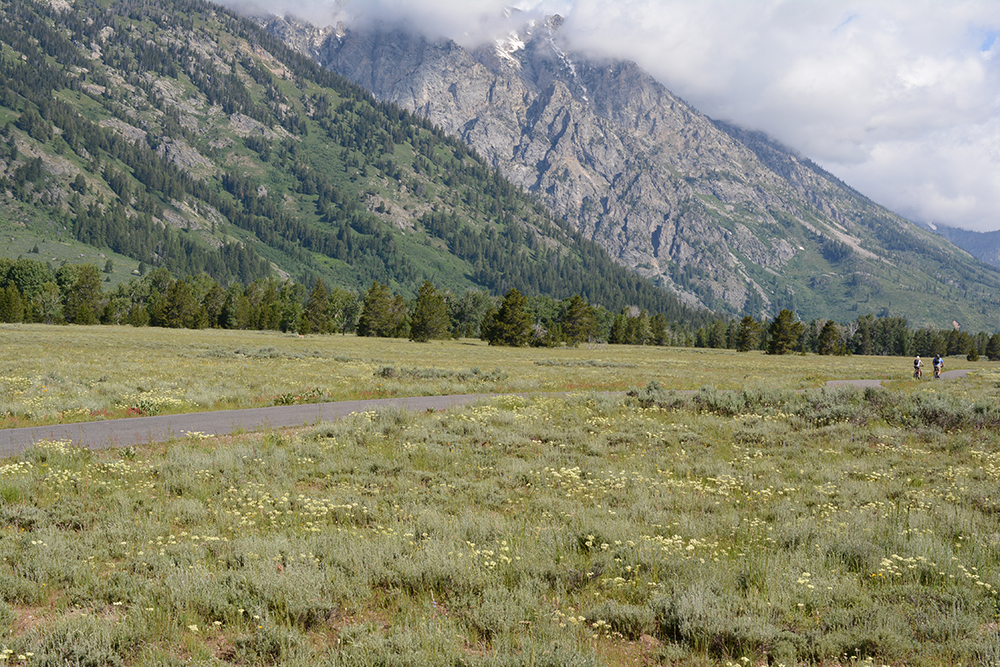
Their sulphur yellow flowers flowers are held in clusters surrounded by a whorl of bracts.

The small leaves form mats beneath.

Scattered in betweenon disturbed ground, such as along the pathway in the park, are drifts of a weedy, reddish annual – Common Sheep Sorrel – Rumex acetosella. The seeds will be relished by many small birds and mammals. And these pioneering annuals help to retain soil and add nutrients and organic matter to the site, paving the way for slower establishing perennials.

Notably, Ambiguous Spring Parsley featured in the May bloom posting is still on the scene, albeit with fewer flowers and more fruits. It is noticeable also along the inner park road edges and road cuts or other disturbed areas.
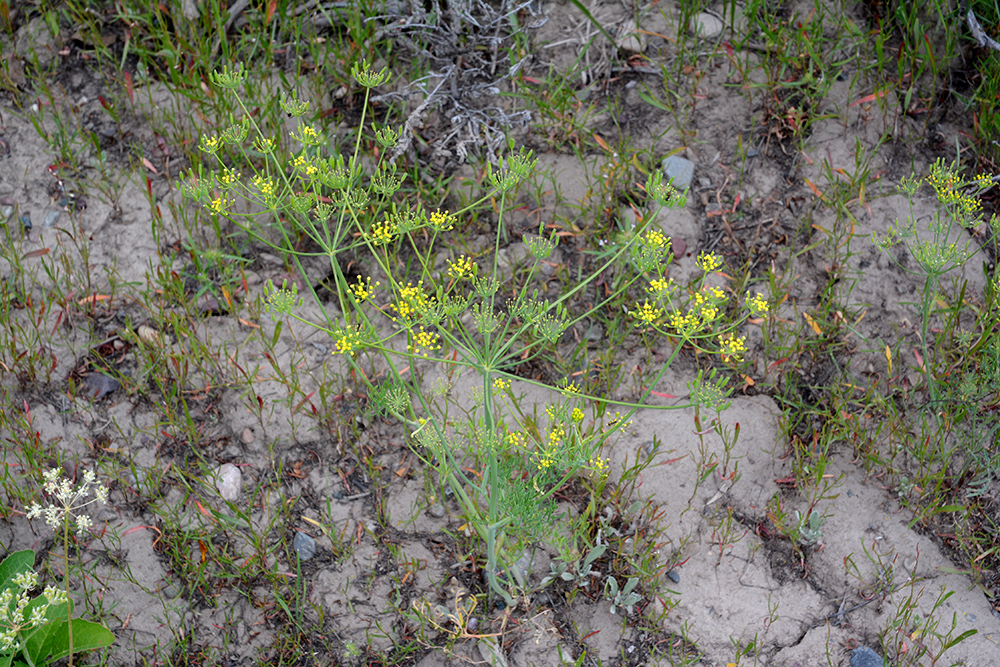
Cinquefoils – Drymocallis/Potentilla – have appeared cheerfully on the scene. Potentillas, now called Drymocallis, have 5 pointed, green sepals; 5 yellow, roundish petals; many anthers; and many, many pistils set on a cone-shaped receptacle in the center. Leaves are either palmately or pinnately compound.
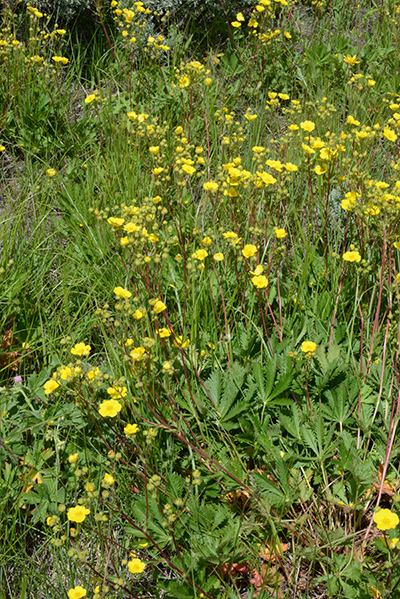
Slender or Graceful Cinquefoil – Drymocallis/Potentilla gracilis – holds out stems with bright yellow flowers. Each petal is marked with a dash of orange at the base.
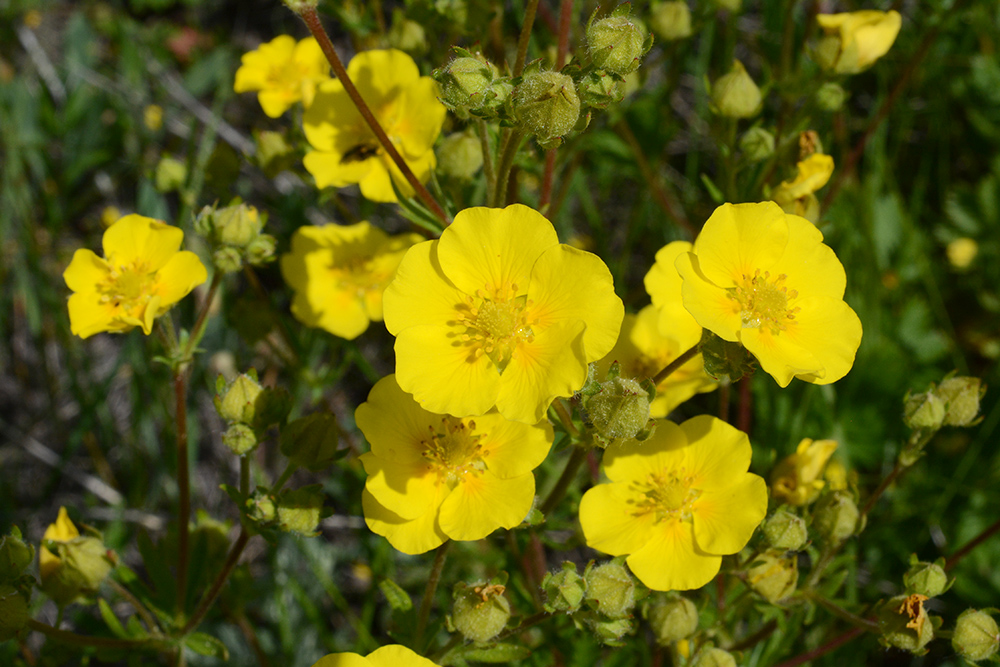
Palmately divided leaves have 5-7 lobes and are toothed.
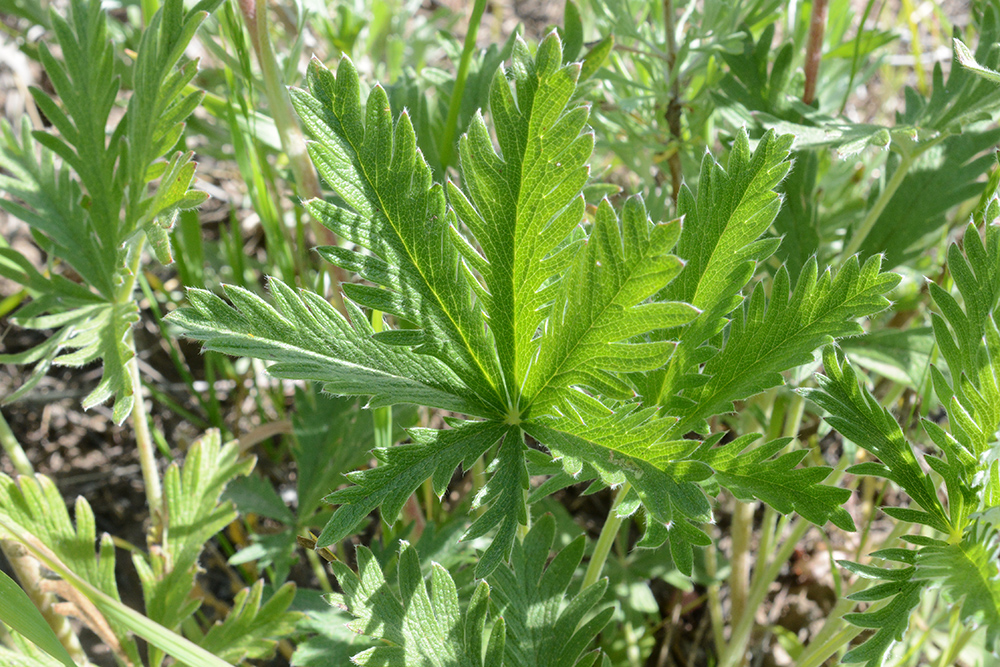
Within the species are at least two subspecies we won’t worry about at the moment.
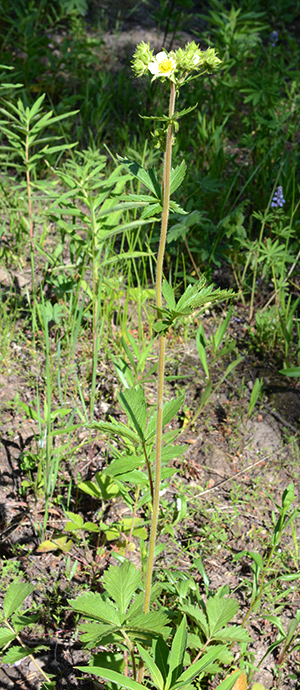
Tall Cinquefoil – Drymocallis arguta – is 2-3’ tall with pinnately divided leaves.
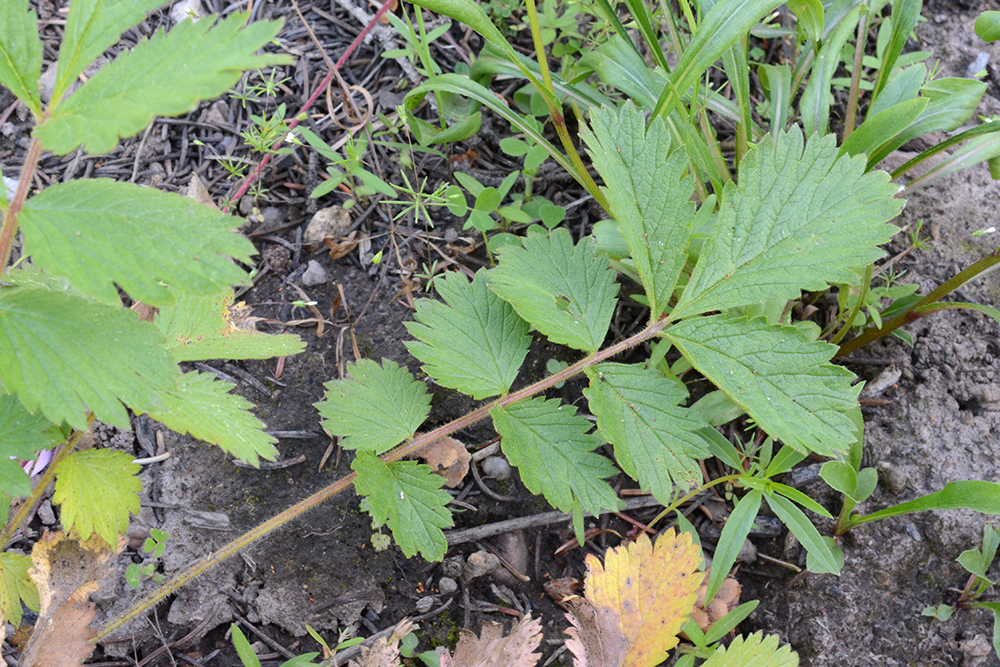
Flowers are pale yellow to whitish and are held up at acute angles to the stem in tight clusters – like fists.

Therefore, I think of argu-mentative to define this arrangement, which may help to remember is as D. argu-ta. The plants are very sticky or glandular on stems and sepals.
Our state flower, Wyoming paintbrush – Castilleja linariifolia is just arriving on the scene.
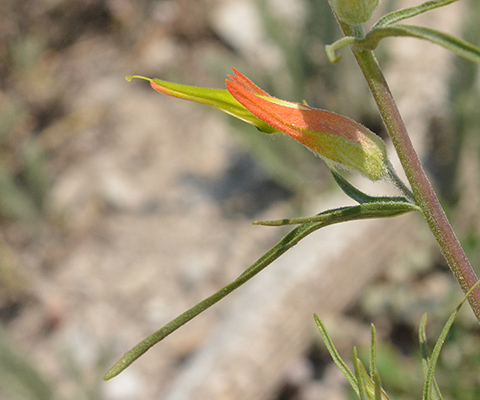
The lean, long green galea extends beyond the orange-red sepals on 2-2.5’ stems.

Leaves are also divided into linear lobes. I think of the lean cowboys of Wyoming.
Notable is the Yampah species found only in Teton County in Wyoming – Bolander’s Yampah Perideridia bolanderi.

It is flourishing along the very north end of the Moose-Wilson Road.
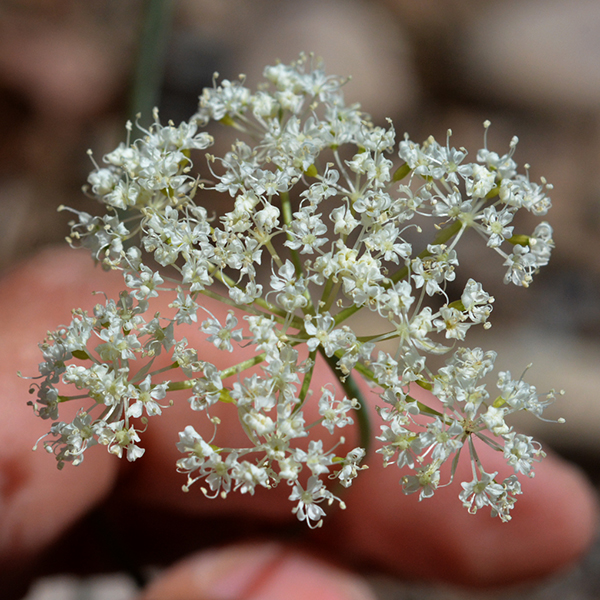
It tends to bloom earlier than the common Yampah – Perideridia gardnerii/montana. Petioles of the leaves are dilated (expanded) where they meet the stem. The leaflets are variable.
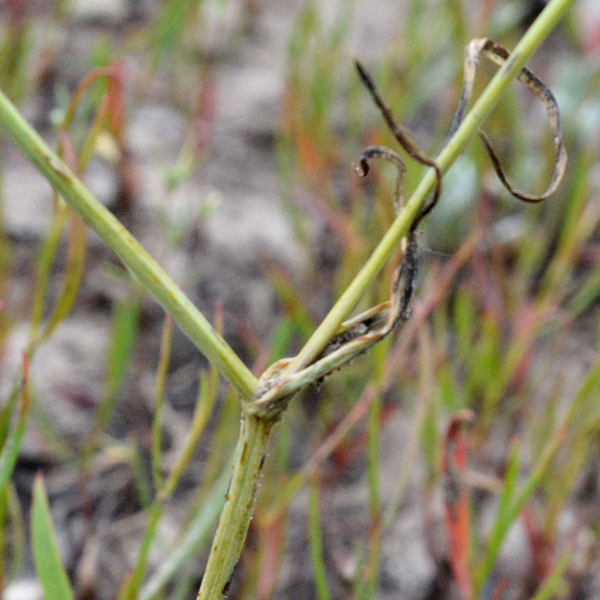
The fruits (schizocarps) will be oblong (vs more rounded).

Some rarer species:
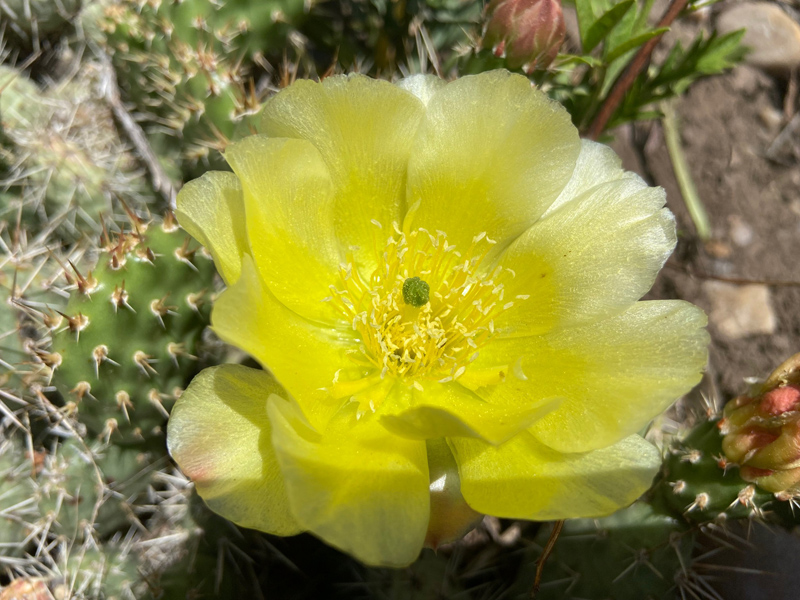
Brittle Prickly Pear Cactus – Opuntia fragilis – is blooming on rocks at Kelly Warm Springs.
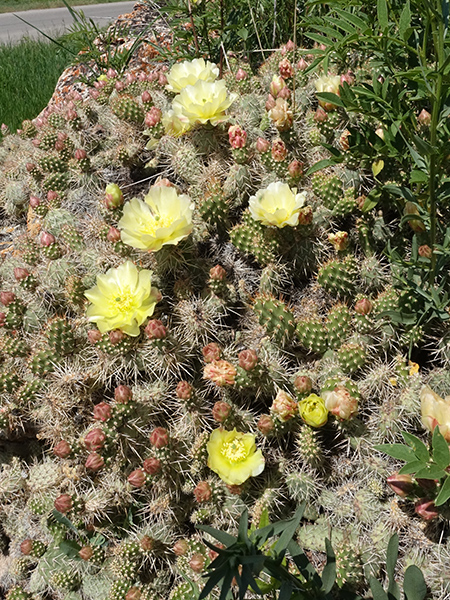
Watch out! The spines attach readily to boot, fur, or you. You can see that the plants are migrating up hill, likely spread by roving wildlife or tourists.
Some folks have been finding the tapered blue flowers of Wild Hyacinth – Tritelia grandiflora.

These elegant blue vase-like flowers are held up on 18” stems which grow from bulbs. They are on the very eastern edge of their range here in western Wyoming. They are in the Lily Family.

Also in the Lily Family, but very different looking are Sego Lilies – Calochortus nuttallii. They sprout from bulbs on very dry slopes. We witnessed flowers being visited by what appeared to be flying ants.
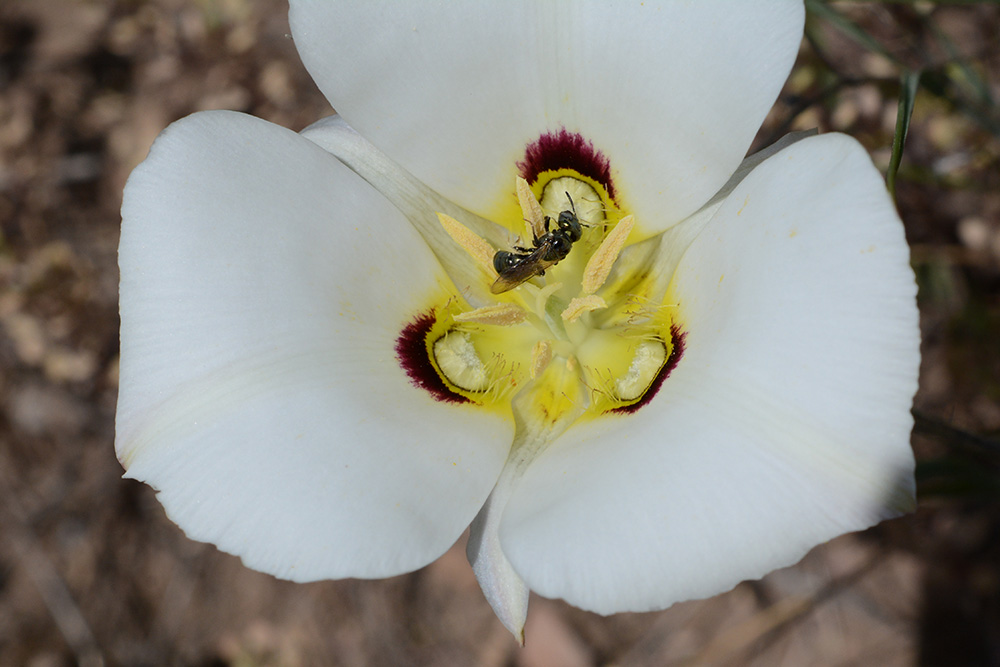
Not sure if they were actual pollinators. Sego lily bulbs have been a traditional food of several Native American groups, and this vital food was introduced by local tribes to the Mormons as a survival food. As a consequence, Sego Lily it is the state flower of Utah. (USDA)
New yellow composites: There are always more composites to identify!
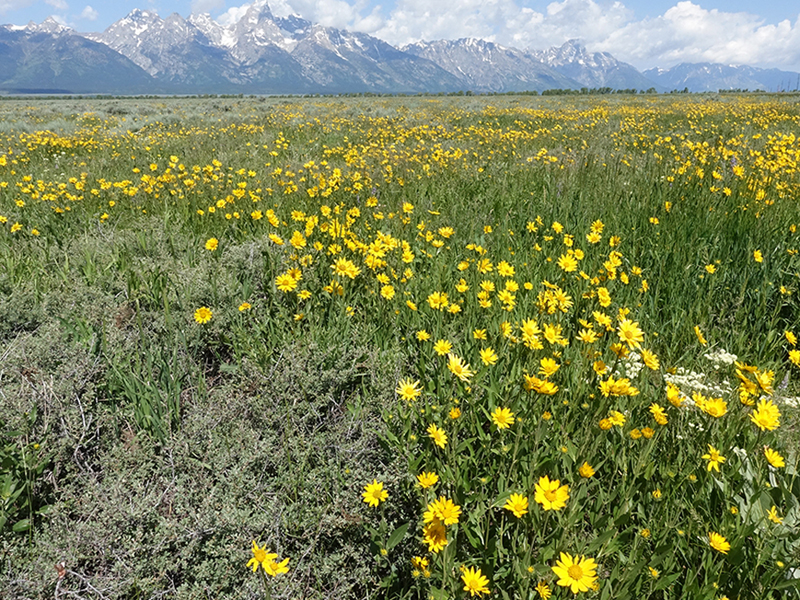
One-flowered Little-sunflowers – Helianthella uniflora – are abundant on slightly more moist sites in sageflats, up hillsides, and under dabbled shade of aspen groves.
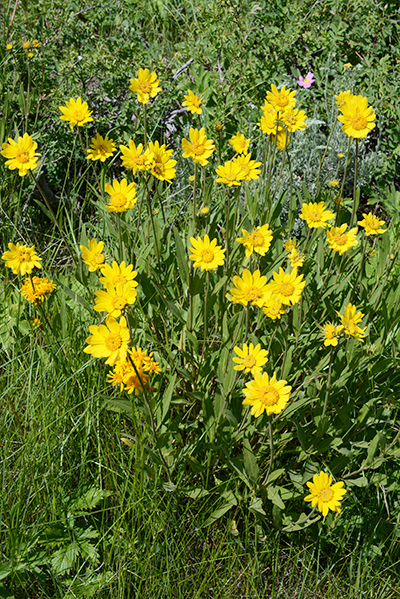
The flowers are held up singly and the leaves have 1-3 visible veins.
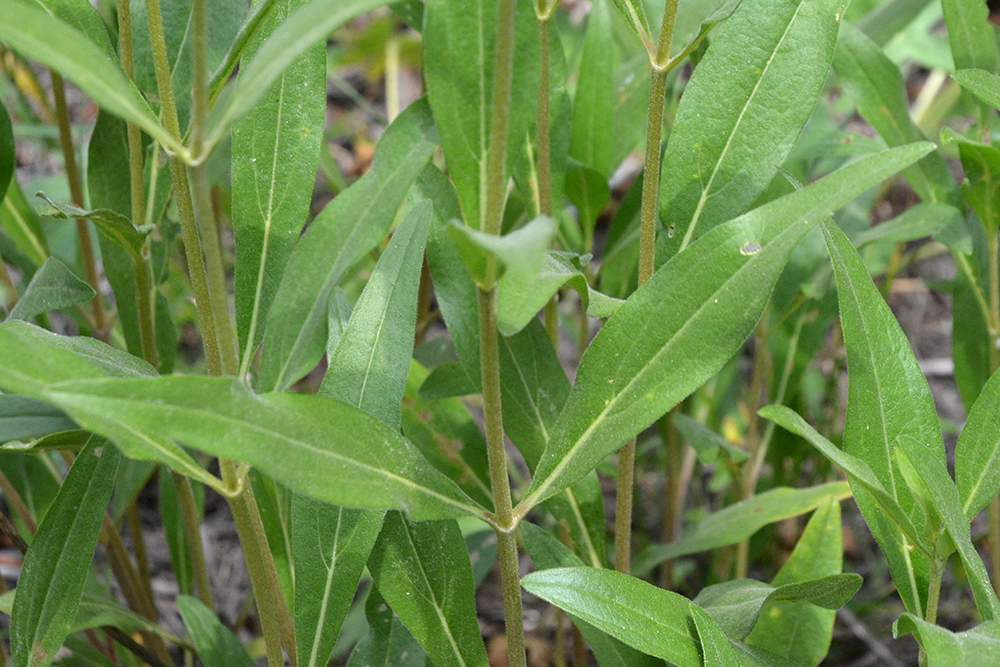
Tapertip Hawksbeards – Crepis acuminata – are showing up here and there.
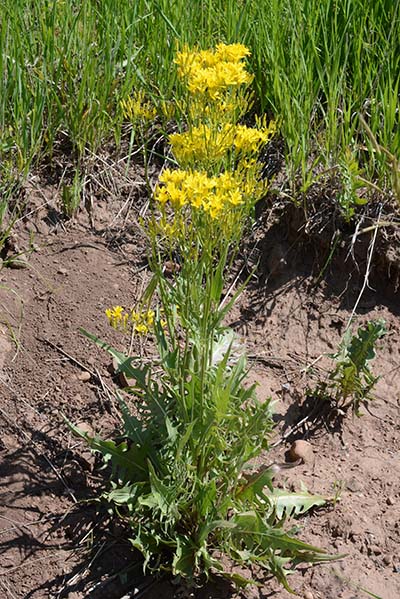
We have several different hawksbeards. This one has many (approx. 40) flower heads on a branching stem, each with about 5-12 ray flowers
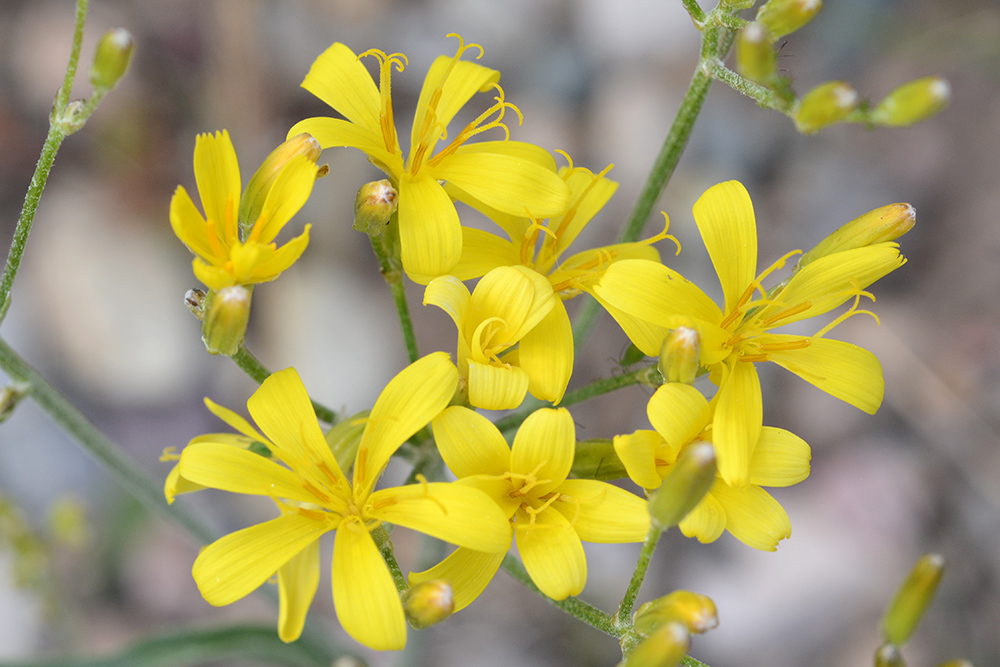
all surrounded by about 5-8 smooth bracts.

The stems and leaves are also essentially smooth. The leaves are about 6” long, mostly basal. Their shape is distinctive with long-tapering tip and deeply incised, pointed lobes.
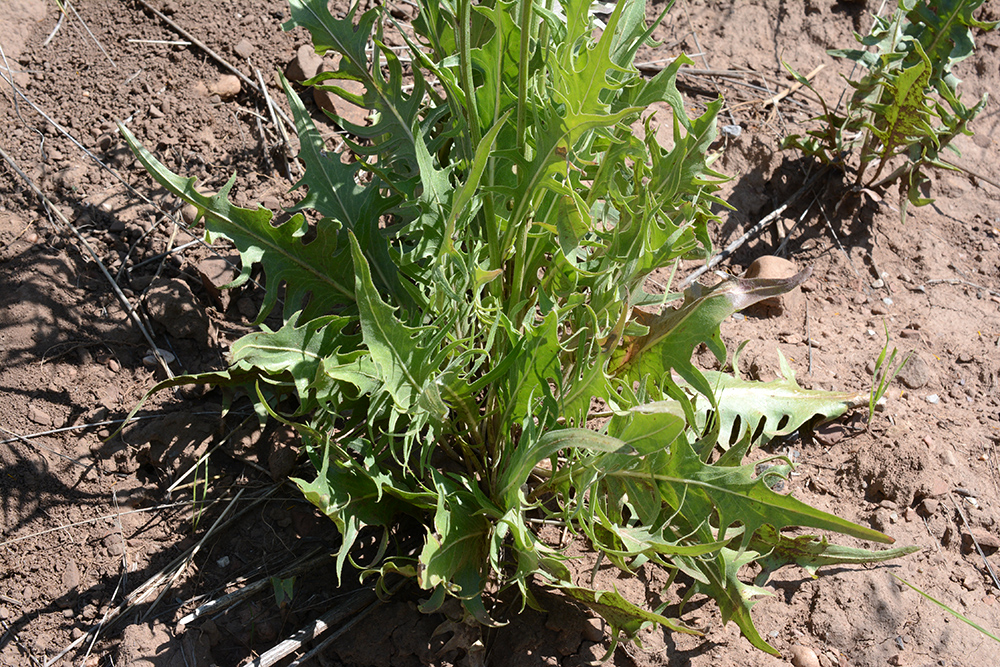
Ragworts/Groundsels – Packera streptanthifolia – is one of three confusing relatively low growing groundsels. ID is based primarily on the highly variable leaves.

This species has tidy yellow flower heads with a few ray flowers with equal-length, smooth bracts, often tipped in black.

Their stem leaves are variably lobed and can slightly clasp the stem.

Most of the truly basal leaves are rounded and taper to the petiole. (Look around carefully for these…in this photo they are upper right corner).
Woolly Sunflower – Eriophyllum lanatum – grows only about 8” tall.
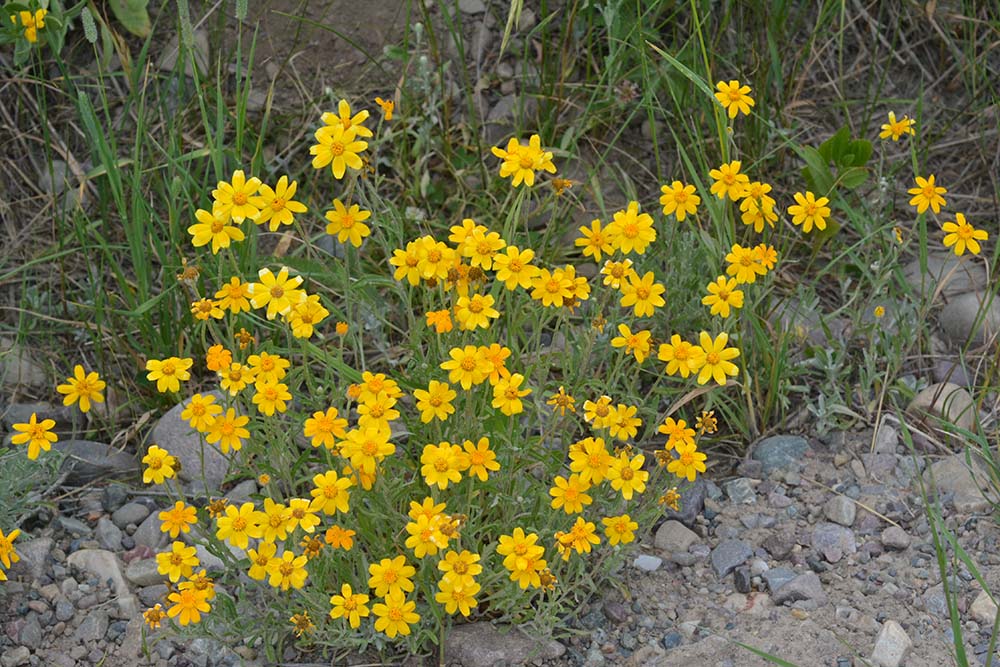
The broad, even-length bracts are slightly pointed and covered in fine white hairs.
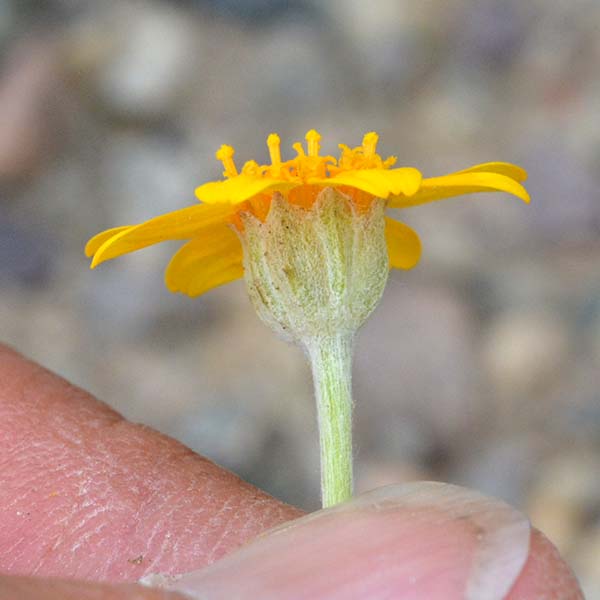
The stems are also tomentose and the 2” linear leaves slightly less so.
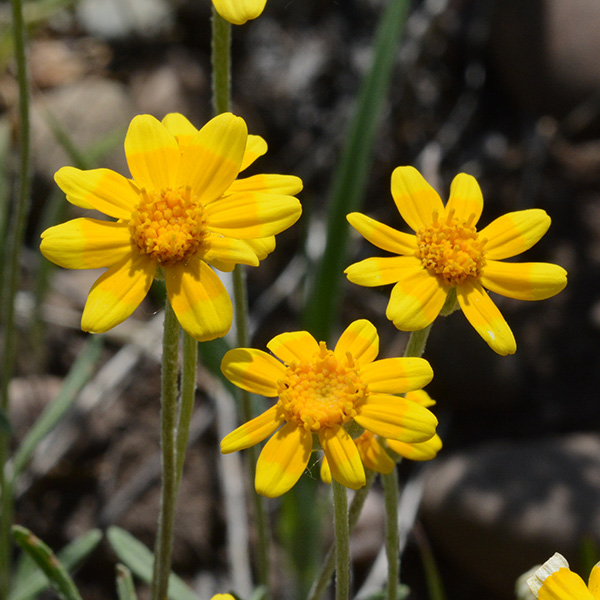
You can notice the slight variation in color of the ray flowers: lighter yellow at the tips grading to a darker almost orange shade toward the base, likely forming a very noticeable “bull’s-eye” to pollinators with ultra-violet vision.
Harder to recognize as a composite is Common Yarrow – Achillea millefolium. The species is found with many variations in chromosome numbers throughout much of North America, Europe, and Asia in relatively dry, lean soils. The composite flower heads consist about 3-5 small, white ray flowers and several disc flowers.

The feathery-looking leaves are finely dissected and very fragrant. Plants spread by rhizomes and can form dense colonies.

For thousands of years this chemically complex species has been used for medicinal purposes. It is named after Achilles of Greek mythology who is said to have used it to aid his wounded soldiers. This robust plant has been selected for colorful cultivars for gardens and can be considered quite aggressive. Needless to say, such a widespread species is also important for all sorts of insect pollinators.
Flowers mostly of meadows to dappled shade of Aspen groves.
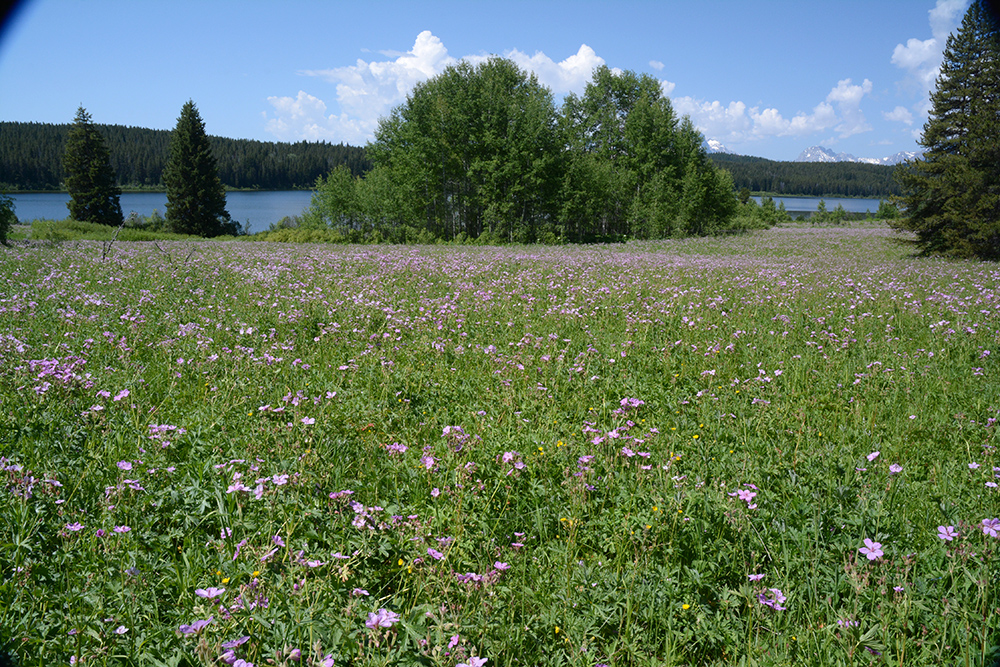
Profusions of Sticky Geraniums – Geranium viscossissimum – cover many areas. Watch as the flowers begin to form their fruits that will catapult the seeds onto new ground.
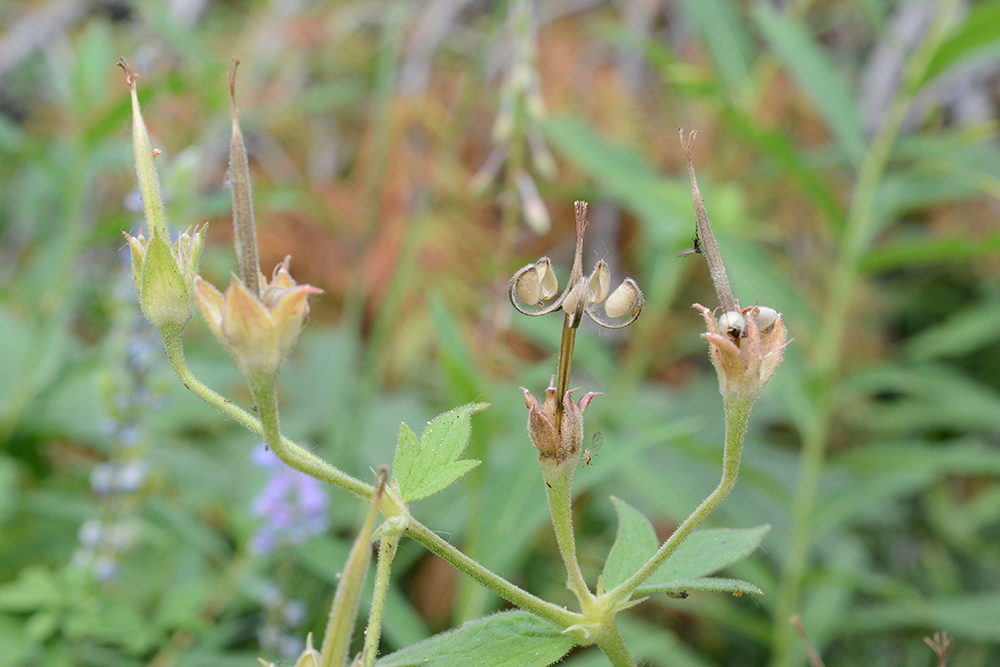
Five-nerved Little-sunflowers – Helianthella quinquenervis – are particularly robust 5-6’ tall in relatively moist meadow sites.
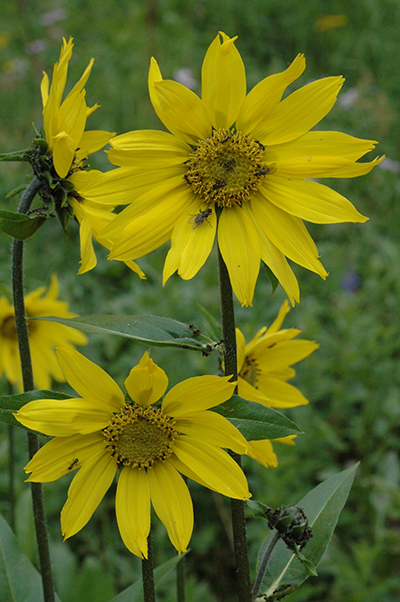
Look for the 5 obvious nerves or veins on their larger lower leaves for ID.
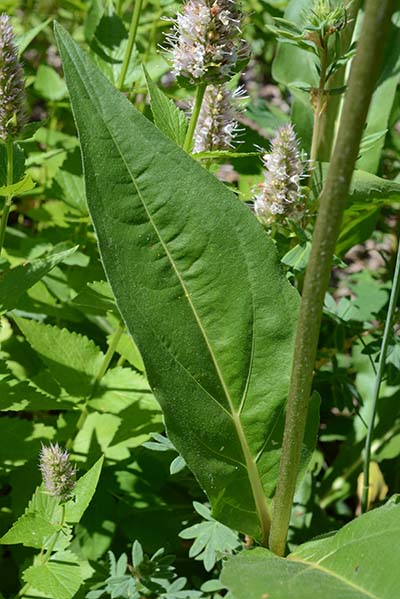
The large heads tend to glare right at you. Later the seeds will be plucked out by pine siskins and goldfinches.
Silvery Lupines – Lupinus argenteus – also grow on open slopes or in part shade, or even in the dense shade of lodgepole pine forests.

To distinguish it from its dry-habitat cousin Silky Lupine – L. sericeus, note the palmate leaves are greener, less hairy (Silky on left,Silvery Lupine on right);

The silvery lupine flowers are smaller, more compact, usually darker,and without silky hairs on the back of the banner.
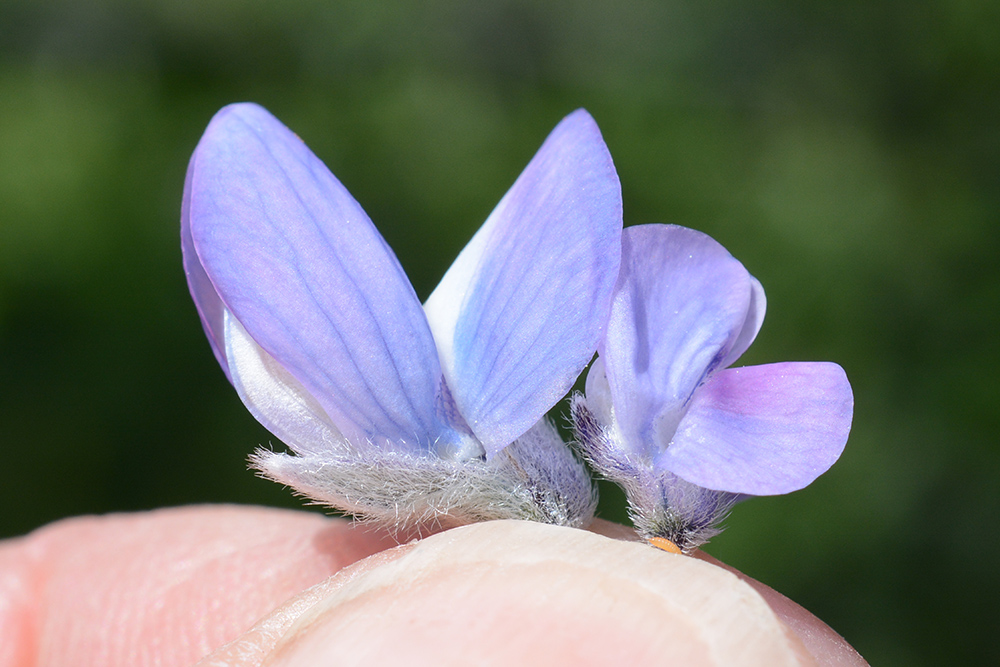
Timber Milkvetches – Astragalus miser – form mostly inconspicuous patches about a 1’ high and wide. The leaves are finely pinnately compound.

The small, pale white-to-bluish pea-like flowers are already producing small pods.

There are many species of of milkvetches – this is one of the most common in these habitats. Remember, milkvetches are toxic to many animals.
Fernleaf Louseworts – Pedicularis bracteosa – are flowering and fast fading in the light shade of Aspen groves or nearby hillsides, but they will soon be common in high meadows such as on the way to Ski Lake.
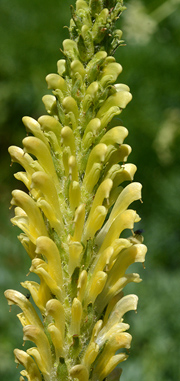
Wild strawberries creep into the verges of fields and forests. They have 3-parted leaves, white 5-petaled flowers with many anthers and pistils. Brown seed-like fruits (achenes) lie on the outside of the swollen red receptacle—forming what we call the “berry”. Note birds and small mammals may gobble delicious fruits before you see them. Plants spread by stolons: creeping stems over the ground.
Woodland Strawberry – Fragaria vesca – has leaves with obvious incised veins and are nearly hairless on the surface, but shaggy underneath. The terminal tooth is usually longer than or equal to the adjacent two teeth.
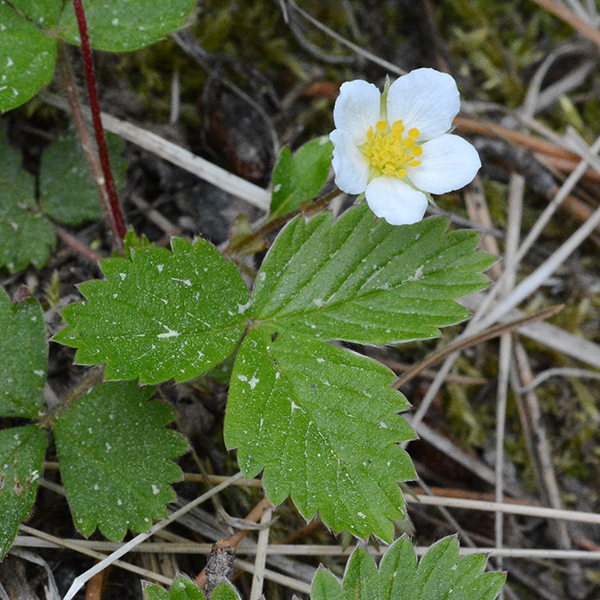
The fruits lie on the surface of the receptacle, similar to our typical domestic strawberry. Flower stems are usually longer than the leaves. (Fruit photo from unknown source on web)
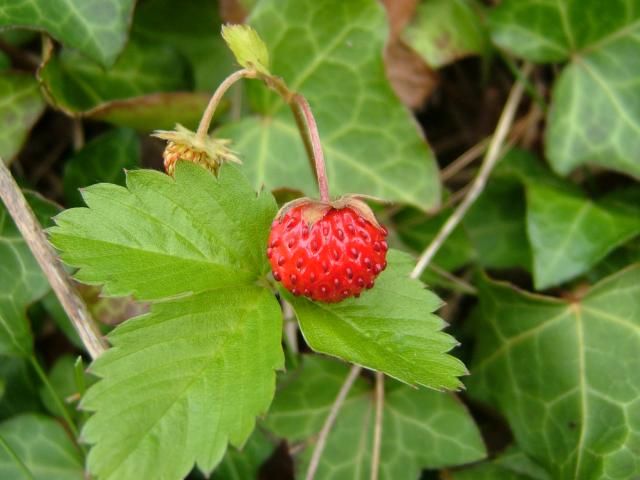
Common Strawberry – Fragaria virginiana – has 3-parted hairy leaves with the terminal teeth usually shorter than the two side teeth.
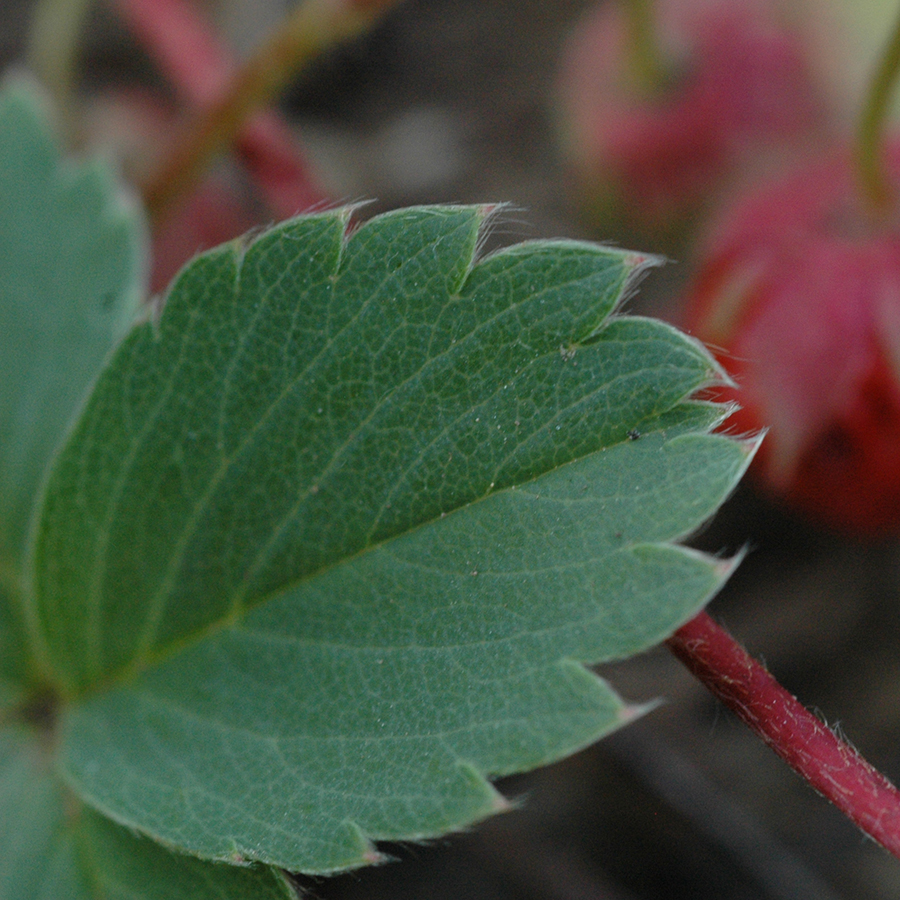
The leaves can have a blue-ish cast to them. Plants tend to be hairier overall than Woodland Strawberries. The best way to ID them for sure is the fruits are embedded in the red flesh of the receptacle.

This species is one of the parents of the cultivated strawberries found in supermarkets.
Great Red paintbrush – Castilleja miniata – is the third red paintbrush seen so far this year. The flower clusters are held at the top of 12″ plus stems and the bracts and calyx tubes are toothed to lobed and surround the more-or-less green galea or petal-tube. The leaves are simple.

This resembles and is often confused with a higher elevation (sub-alpine) species Rosy Paintbrush – C. rhexifolia.
Sulphur Paintbrush – Castilleja sulphurea – flowers are also clustered at the top of approx. 18″ stems. They have pale-yellow, broad, rounded bracts and rounded, toothed sepals.

Paintbrushes are notoriously difficult to ID as they can hybridize, self-fertilize, and generally muddle their chromosomes. Therefore bract and sepal shapes, sizes, and colors can range widely in appearance.
Fernleaf-Licorice Root – or Northern Osha – Ligusticum filicinum – is a new member of the Carrot Family appearing on the scene with its delicate domes of many fine umbels of white flowers that stand above finely dissected carrot-like leaves. (They are related to carrots).
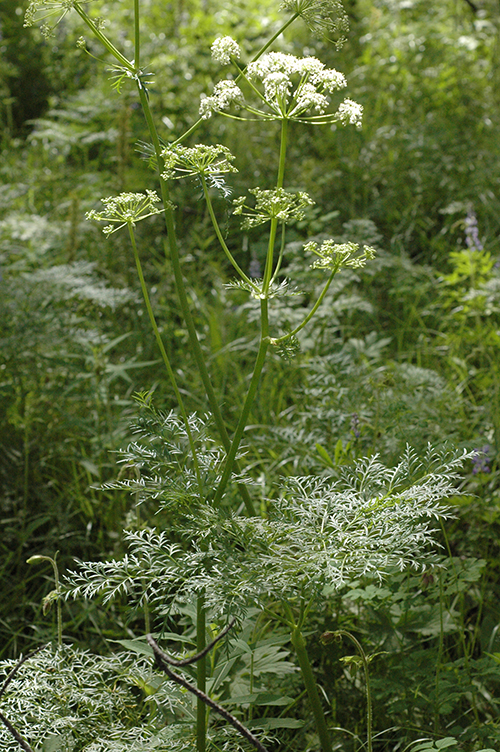
The root beneath the 3-4’ plants is thick and fragrant. These plants and close relatives have been used by tribal groups for thousands of years for various medicinal purposes. An interesting reference. regarding its use is provided by Ben Clark formerly of Wilson.

Tall meadows are growing into their full splendor along the bumpy dirt road to Two-Ocean Lake in the Park. They include several of the flowers mentioned above: Sticky Geraniums, Five-nerved Sunflowers, Silvery Lupines, and Northern Osha.
Hard to Miss – Green Gentian or Monuments Plants! – Their story…

Green Gentian/ Mounument Plant – Frasera speciosa – is having a big year.
These perennial “monocarpic” plants first form rosettes of leaves.
The first few years, plants may exhibit only 1-2 leaves; if conditions go well, they will add another leaf or so each year. They use the summer leaves to store food down into their deep taproot for the winter. Depending on the previous growing year, in spring a plant produces a larger rosette which, in turn, stores more food.
Part of their energy “budget” is spent on defense. Each year they not only need energy to produce new leaves, but also, they need to manufacture enough chemicals to keep away predators…I see few blemishes on a leave. Defense is expensive as we know from our national military budget.

Years go by as the rosettes slowly become more and more leafy each year. Eventually, enough leaves (at least 20) will have stored enough food. Certain weather conditions (still being researched) then trigger flower-bud formation deep down. A given geographical area is subject to the same weather conditions.

Three to four years later, the plant produces a 4-6’ spire producing dozens of flowers. The flowers are open to all sorts of pollinators who show up and indeed fertilize the plants.
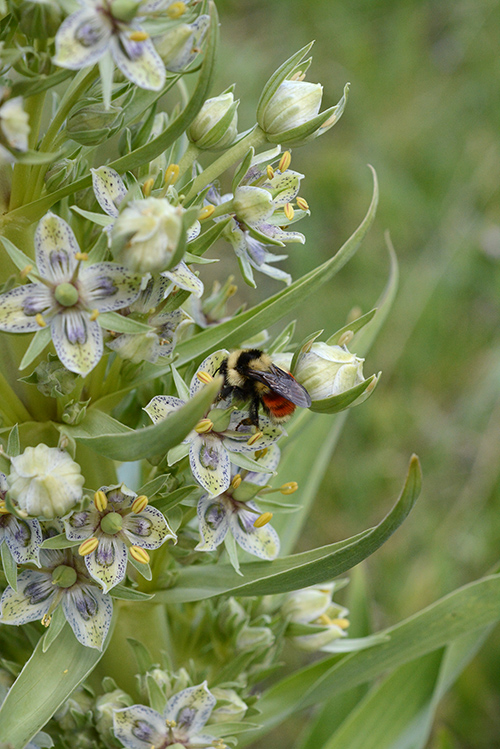
And by late summer, capsules have formed with dozens of seeds inside each. Each Green Gentian plant produces hundreds of flowers, thousands of seeds and then dies (similar to Century Plants).
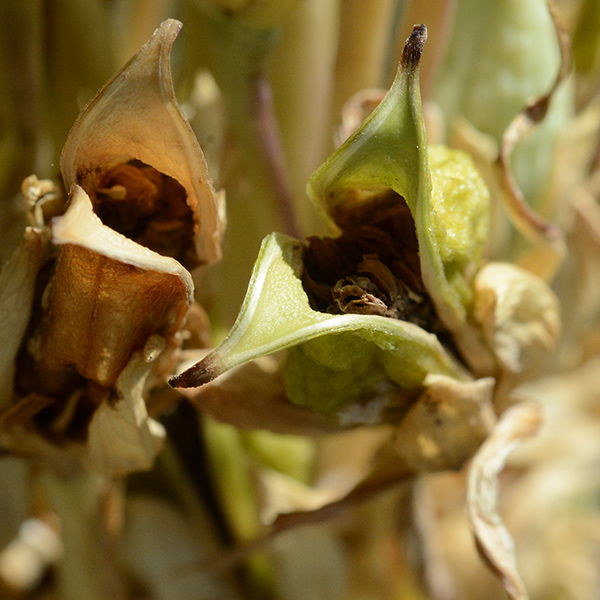
Seeds shaken out by the wind often land not far from the parent where they are shaded and nourished by the parent plant decomposing above them. Seeds are gobbled up by predators; but with so many, at least some seeds are missed. With luck, they will germinate and start growing single leaves, year by year. It takes decades to grow from seed to flower!
So, what we are seeing now is synchronicity of flowering triggered 3-4 years ago. We often overlook all the rosettes of various sizes still accumulating enough energy for the next big bloom cycle. For more info see University of Colorado article.
We hope this posting catches you up on the more common plants of sun and shade. Note the species we have seen in the past month or so will be showing up at higher elevations and in different densities and combinations as the summer continues on. Check out past postings, too. Many cover the same species or others found at similar date of posting.
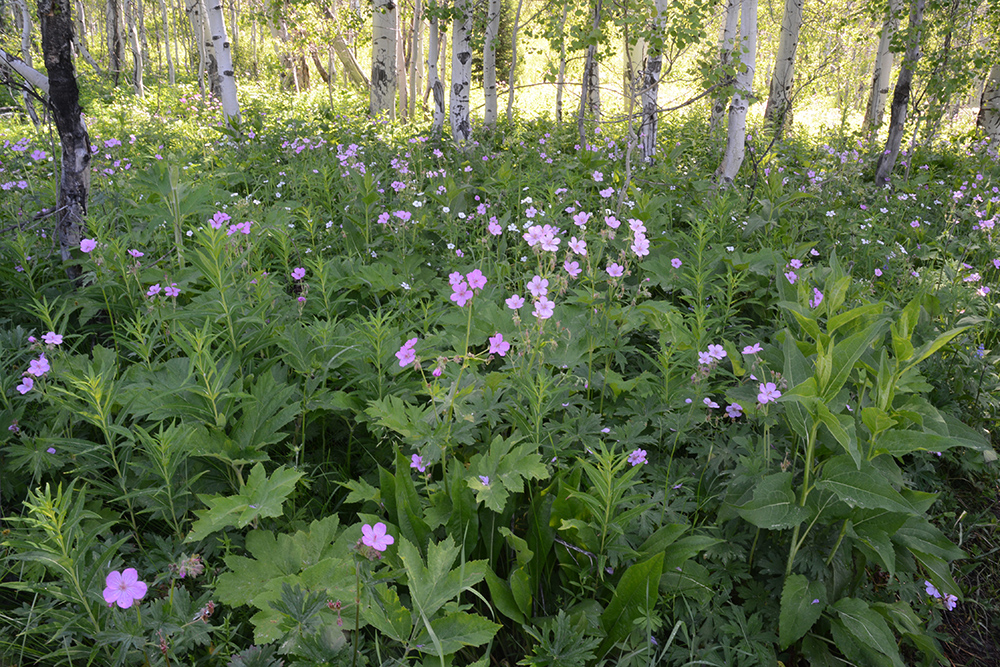
Have fun!
Frances Clark, Teton Plants, Wilson, WY
July 10, 2023
As always we appreciate corrections. Some of these species are hard to ID. We want to make sure we are putting out correct info. Any questions or suggestions, please contact us at tetonplants@gmail.com. Thank you!

